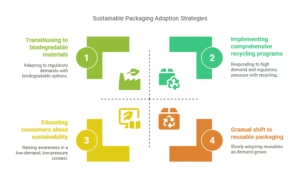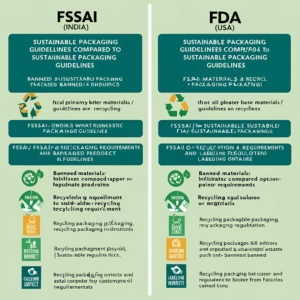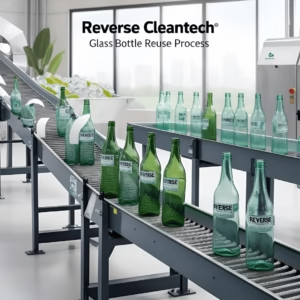Introduction:

The Urgency of Transitioning to Sustainable Packaging
We all know the use of plastic in the food industry and how much harm we cause to our Mother Earth.
But now we all have become very aware of the harms caused by the use of plastic.
There is only one solution to reduce all these things Sustainable packaging.
Sustainable packaging is no longer just an option but has become a necessity.
Due to sudden environmental changes and strict regulations, businesses will now have to adopt eco-friendly alternatives; no other solution is visible.
There is a lot of pressure, especially on the food industry, to reduce waste and adopt innovative packaging solutions that are cost-effective and sustainable, because most of the plastic material is used for food packaging.
Companies that adopt sustainable packaging improve their brand reputation, increase consumer trust, and also financial benefits. In this article, we will discuss the most sustainable packaging solutions, regulatory policies, market trends and practical solutions that can assist businesses in this transition.
Regulatory Information: FSSAI and FDA Guidelines
FSSAI Regulations on Food Packaging

To reduce the increasing plastic waste, FSSAI has made very strict guidelines which are as follows
- Ban on Single-Use Plastics: To prevent environmental damage.
- Mandatory Recycling Standards: Requires food businesses to use recyclable packaging materials.
- Labeling Requirements: Stated clearly on label identification of biodegradable and compostable packaging.
FDA Guidelines for Sustainable Packaging
The United States Food and Drug Administration (FDA) regulates packaging materials to ensure they do not compromise food safety major guidelines are:
- Non-Toxic Material Use: Ensuring all the packaging is non-toxic in nature.
- Standards for Recyclability: Encouraging companies to opt for recyclable and reusable packaging.
- Sustainable Sourcing Specifications: Encouraging the use of renewable sources.
Market Statistics and Consumer Trends
Latest reports emphasize the increased need for environmentally friendly packaging:
- 85% of consumers want eco-friendly packaging (Nielsen Report, 2024).
- Brands using sustainable packaging report a 40% increase in sales (Green Business Survey, 2024).
- Governments across the world provide tax credits to companies moving towards eco-packaging.
How Businesses Can Switch to Sustainable Packaging
1. Begin Small with Incremental Adjustments
- Transition away from single-use plastic and shift to biodegradable ones.
- Educate staff and customers about the benefits of sustainable packaging.
2. Capitalize on Government Initiatives
- India: Subsidies up to 25% for eco-packaging available through PMEGP scheme.
- USA & EU: Tax credits worth up to $5,000 for switching over to eco-friendlier ones can be availed.
3. Make Customers Aware of Sustainability
- Label packaging with “100% Plastic-Free” or “Compostable Material”
- Highlight green efforts on social media.
Reverse Cleantech Role in Glass Bottle Reuse

Reverse Cleantech is revolutionizing sustainable packaging by introducing a glass bottle reuse program for alcoholic and non-alcoholic beverages. Their label peeling technology and efficient recycling methods help reduce waste and minimize environmental impact, setting an industry benchmark for eco-friendly packaging. By adopting advanced cleaning and sanitization techniques, Reverse Cleantech extends the lifecycle of glass bottles, reducing the need for new production and lowering carbon emissions.
Sustainable Packaging Materials & Cost Comparison
| Material | Cost (vs Plastic) | Best For | Sustainability Benefits |
|---|---|---|---|
| Bagasse (Sugarcane Waste) | ₹8 (vs ₹6) | Takeaway containers | Fully biodegradable |
| Edible Rice Paper | ₹1.50 (vs ₹0.80) | Snacks, sweets | Edible & compostable |
| Palm Leaf Trays | ₹12 (vs ₹9) | Street food | Naturally decomposable |
| Cornstarch PLA | ₹15 (vs ₹10) | Cold beverages | Recyclable & compostable |
| Recycled Paper | ₹5 (vs ₹3) | Dry foods | Reduces deforestation |
Conclusion: The Business Benefits of Sustainable Packaging
Sustainable packaging is not just an environmental initiative-it’s a sound business strategy. Businesses that adopt sustainable practices enjoy increased customer involvement, regulatory compliance, and higher sales. Investing in sustainable packaging is an investment in the future of the planet and profit.
Key Business Benefits:
- Cost Savings: Long-term savings on waste disposal.
- Regulatory Compliance: Avoid large fines and operate with ease.
- Consumer Trust: Increased brand image and customer loyalty.
What to Do Next:
- Replace one packaging item this month.
- Research subsidies and incentives in your area.
- Promote your sustainable practices to appeal to environmentally conscious consumers.
Through these changes, companies can remain ahead of the curve while increasing brand loyalty and sales.
Frequently Asked Questions (FAQ)
1. What are the most cost-effective sustainable packaging options?
Bagasse, recycled paper, and cornstarch PLA are among the most affordable and widely used eco-friendly materials.
2. Are there government incentives for switching to sustainable packaging?
Yes, many countries provide tax benefits and grants for businesses that implement sustainable packaging solutions.
3. How does sustainable packaging impact a brand’s reputation?
Consumers are more likely to support brands that prioritize sustainability, leading to increased sales and stronger brand loyalty.
4. What are the common challenges in adopting sustainable packaging?
Higher initial costs, sourcing eco-friendly materials, and ensuring compliance with regulations can be challenging but manageable with proper planning.
5. How can Reverse Cleantech help businesses transition to sustainable packaging?
Reverse Cleantech offers innovative glass bottle reuse solutions, reducing waste and lowering carbon footprints for beverage companies.
About the Author
Vaibhav is an expert in food safety and sustainability with over 5 years of experience in the food industry. Linkedin
If you want read our another article please visit to our article page
Perishable Food: Storage, Safety, and Best Practices

Pingback: Reusable vs. Recyclable vs. Compostable: Best Sustainable Food Packaging (2025) - foodtechzone